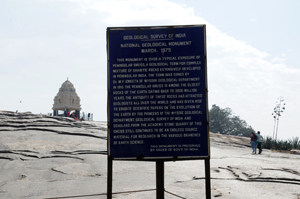Morning walkers fear that it may be damaged by the use of heavy drilling machinery by personnel hired to rejuvenate the lake in the garden
The rock, termed Peninsular Gneiss, is a mixture of granitic rocks
The use of heavy drilling machinery by construction personnel hired to rejuvenate the lake in the renowned Lalbagh botanical gardens has several morning walkers and joggers worried. They fear that work would endanger the 3,000 million years old Peninsular Gneiss, the rock in the centre of the park. The personnel are cutting huge boulders using earth movers, near the Siddapura Gate. Dr Krishna, a morning visitor to the park, told Bangalore Mirror, “I saw these machines near the rock a few days ago. Vigilance officers informed them that they were drilling the earth to cut rocks. None of us had any clue where those rocks were transported.”
Special white stone boulders have been brought from Pavagada to construct a bund along the recently rejuvenated Lalbagh lake. They are not only huge but irregular in shape as well. Hence, they have are being cut to fit our requirements. As there was no vast space available within the park to take up the drilling and chiseling work, we chose the empty space near Siddapur Gate, which was sometimes used as a parking lot.” But when asked whether the drilling work with high level vibrations would damage the texture of the geologically significant rock, Krishnappa clarified, “They have just cleared the soil to keep the boulders intact while drilling and chiseling using heavy machines. We have been vigilant at every step.”
